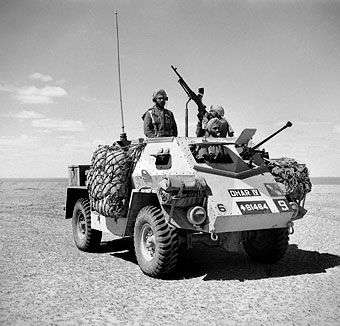18th King Edward's Own Cavalry
The 18th King Edward's Own Cavalry was a regular cavalry regiment in the British Indian Army. It was formed in 1921, by the amalgamation of the 6th King Edward's Own Cavalry and the 7th Hariana Lancers. These regiments had served the British Crown from prior to the Indian Mutiny through to 1921. The amalgamated 18th King Edward's Own Cavalry continued this tradition, and fought in the Second Mohmand Campaign and the Second World War
| 18th King Edward's Own Cavalry | |
|---|---|
| Active | 1921-present |
| Country | India |
| Allegiance | |
| Branch | |
| Type | Cavalry |
| Size | Regiment |
| Part of | Indian Cavalry Corps |
| Patron | King Edward VII |
| Engagements | Gwalior Campaign First Anglo-Sikh War Third Ango-Burmese War 1882 Anglo-Egyptian War First World War Second Mohmand Campaign Second World War |
| Battle honours | Punniar Moodkee Ferozeshah Sobraon Egypt 1882 Tel-El-Kebir Punjab Frontier |
| Commanders | |
| Colonel of the Regiment | Walter Cowan |
Second World War

In December 1940, during the Second World War, the regiment was mechanized. It formed part of the 3rd Indian Motor Brigade, which was initially part of the 1st Indian Armoured Division.[1]
The brigade was detached from the division, and dispatched to Egypt along with its units including the 18th King Edward's Own Cavalry. The regiment then served in the Western Desert Campaign. The regiment, and the brigade, were attached to a number of different formations that included the 2nd Armoured Division, the 7th Armoured Division, and the 9th Australian Division who they were with during the Siege of Tobruk.[1] The regiment also supplied men for the Indian Long Range Squadron. The brigade was later overrun by the Italians during the Battle of Gazala, and took some days to reform. After the brigade reformed, the regiment was equipped as follows: Cavalry Carrier - 2 x Recon Sqn, 1 x AT Sqn.[2][3][4]
On 30 June, the brigade was ordered to hand over 50 per cent of its vehicles to the Eighth Army, and was dispersed and the regiment was allotted to the defence of the Nile Delta and guard duties. In August, the brigade reformed and was allocated the regiment. It travelled overland to Sahneh, in Persia via Baghdad, and was placed under the command of the 31st Indian Armoured Division (formally the 1st Indian Armoured Division). In late November it then moved to Shaibah, 7 miles (11 km) from Basra. From here the regiment returned to India in January 1943, and the brigade was reconstituted as the 43rd Indian Infantry Brigade (Lorried) at Shaibah at the end of January 1943. In the middle of the year, it moved to Rawalpindi and commenced conversion to a light cruiser regiment. By the end of the year, the regiment successfully converted into a light cruiser tank regiment. The regiment was split up after that, serving in different parts of India when the Japanese surrender came in August 1945.
The regiment became part of the Indian Army when British India was partitioned in 1947. It was renamed the 18th Cavalry in 1950.[5] It remains active as of 2019.[6]
Battle honours
The regiment was awarded the following battle honours:[7]
- awarded to 6th King Edward's Own Cavalry
Punniar, Moodkee, Ferozeshah, Sobraon, Egypt 1882, Tel-el-Kebir, Punjab Frontier[8]
- awarded to 7th Hariana Lancers
- First World War
Awarded in 1926 for services of predecessor regiments
Somme 1916, Morval, Cambrai 1917, France and Flanders 1914–18, Megiddo, Sharon, Damascus, Palestine 1918, Shaiba, Kut-al-Amara 1915, Ctesiphon, Tigris 1916, Mesopotamia 1915–16
- Second World War
El Mechili, Defence of Tobruk, The Kennels, North Africa 1940–43
- Independent India
References
- "mod.nic". Archived from the original on 4 April 2008. Retrieved 6 July 2008.
- Mackenzie (1951), p. 71
- "axisforam". Retrieved 6 July 2008.
- "rothwell". Retrieved 6 July 2008.
- "18th King Edward's Own Cavalry". hcvv.home.xs4all.nl. Retrieved 16 October 2019.
- "Fighting for India in a foreign land". The Indian Express. 11 October 2019. Retrieved 16 October 2019.
- "18th King Edward VII's Own Cavalry at regiments.org by T.F.Mills". Archived from the original on 20 April 2007. Retrieved 16 July 2015.
- "6th King Edward's Own Cavalry at regiments.org by T.F.Mills". Archived from the original on 16 August 2007. Retrieved 16 July 2015.
- "7th Hariana Lancers at regiments.org by T.F.Mills". Archived from the original on 18 April 2007. Retrieved 16 July 2015.
Further reading
- Kempton, C (1996). A Register of Titles of the Units of the H.E.I.C. & Indian Armies 1666–1947. Bristol: British Empire & Commonwealth Museum. ISBN 978-0-9530174-0-9
- Gaylor, J (1992). Sons of John Company: The Indian and Pakistan Armies 1903–1991. Stroud: Spellmount Publishers Ltd. ISBN 978-0-946771-98-1
- Bengal Cavalry Regiments 1857–1914 By R. G. Harris, Christopher Warner. ISBN 978-0-85045-308-9
- Gurcharn Singh Sandhu, I serve ("Ich dien"): saga of the Eighteenth Cavalry, Lancer International, 1991 (Original from the University of California) Digitized 4 Sep 2008, ISBN 81-7062-104-6, ISBN 978-81-7062-104-1
External links
Follow this link to view the uniforms of the late 19th Century